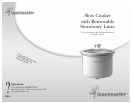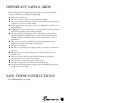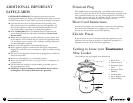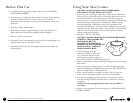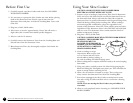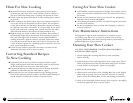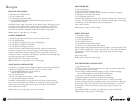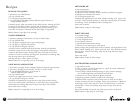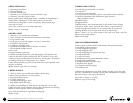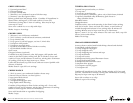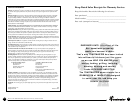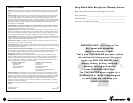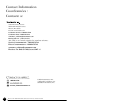
7.
Caring For Your Slow Cooker
◆ Avoid sudden, extreme temperature changes. For example, do not
place a hot Glass Lid or Stoneware Liner into cold water or onto a
wet surface.
◆ Do not use the Stoneware Liner to store food in the refrigerator,
and then reheat in the Cooking Base.
◆ Avoid hitting the Stoneware Liner and Glass Lid against the faucet
or other hard surfaces.
◆ Do not use Stoneware Liner or Glass Lid if chipped, cracked, or
severely scratched.
User Maintenance Instructions
This appliance requires little maintenance. It contains no user
serviceable parts. Do not try to repair it yourself. Any servicing
requiring disassembly other than cleaning must be performed by a
qualified appliance repair technician.
Cleaning Your Slow Cooker
CAUTION: NEVER IMMERSE COOKING BASE OR CORD IN
WATER OR OTHER LIQUID.
1. Always unplug after cooking and allow to cool completely
before cleaning.
2. Wash Stoneware Liner and Glass Lid in warm, soapy water. If food
sticks to the Stoneware Liner, fill with warm soapy water and allow
to soak, before cleaning with a plastic scouring pad.
3. Rinse and dry thoroughly.
4. Wipe interior and exterior of the Cooking Base with a soft, slightly
damp cloth or sponge. Never use abrasive cleansers or scouring
pads to clean the Cooking Base, as they may damage the surfaces.
5. Allow to dry thoroughly before storing. Never wrap the cord tightly
around the appliance; keep it loosely coiled.
6.
Slow Cooker With Removable Stoneware Liner Use and Care Guide
Hints For Slow Cooking
◆ Meats will not brown during the cooking process. If you desire
browning the meat first, heat a small amount of oil in a skillet on
the stove and brown meats prior to putting into Stoneware Liner.
◆ Whole herbs and spices flavor better in slow cooking than crushed
or ground.
◆ When cooking in the Slow Cooker, reduce the amount of liquid in
any recipe that is not designed for a Slow Cooker. The exceptions
to this rule would be rice and soups. Remember, liquids can always
be added at a later time if necessary. If a recipe results in too much
liquid at the end of the cooking time, remove the Glass Lid. After
about 30 to 60 minutes, the amount of liquid should be less.
◆ High fat meats can result in dishes with less flavor. Pre-cooking or
browning will help reduce the amount of fat and help to preserve
the color. The higher the fat content, the less liquid needed. If
cooking meat with a high fat content, use thick onion slices under
it so that the meat will not sit and cook in the fat. If necessary, use
a slice of bread, a spoon, or a straining spoon to skim off excess fat
from top of foods before serving.
◆ Foods cut into uniform pieces will cook faster and more evenly
than foods left whole such as roast or poultry.
Converting Standard Recipes
To Slow Cooking
◆ Vegetables such as carrots, potatoes, turnips, and beets require
longer cooking times than most meats. Place them on the bottom
of the Stoneware Liner and cover them with liquid.
◆ Evaporated milk may be added at the start of cooking. If possible,
substitute condensed soups for fresh milk or yogurt.
◆ Rice and pasta are not recommended for long cooking periods.
Cook them separately and then add to the Slow Cooker during the
last 30 minutes, or follow Slow Cooker recipe directions.



